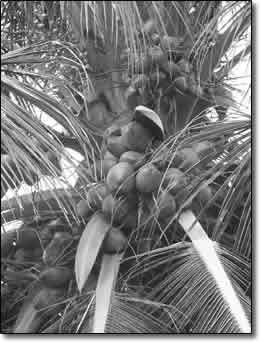
Ode to the coconut
by Chef Boy Ari

There is nothing in the world like the coconut, so compatible with humans that we must have been made for each other. The water of the young, green coconut has the same ph as human plasma and was used during World War II as an intravenous glucose solution. And if you aren't into direct injection, simply drinking the water of the green coconut is like taking your body to Jiffy Lube. The coconuts that you see at the store are mature, brown coconuts, whose sugary water has turned to fatty flesh, so fatty that it makes the second-fattiest vegetable oil on the planet, second only to it's cousin, palm oil. This fat content, combined with its unique flavor, make coconut useful for all parts of the culinary spectrum, from sweet to savory, breakfast through dinner. This is a story about one such use. And it's a story about how I became known as Gringão.
I'm writing from Salvador da Bahia, Brazil. This is a place that affords a privileged perspective on all things coconut, because coconuts are everywhere.
Also integral to the story of Gringão is the beautiful and poetic language of Portuguese. Here is a quick Portuguese lesson: adding the ending "ão" (pronounced "ow") to a word means that the thing that word describes is big and impressive. For example, there is a song called "Eu so Negao" - "I am a big black man." (In Salvador, calling someone a negão, no matter what color they are, is considered a compliment.)
The other key player in this culinary drama is tapioca, a starch derived from the root of the cassava plant. Like the coconut, tapioca has a multitude of uses here in Brazil. And like the coconut, you can get tapioca in the frozen north.
There is a breakfast drink sold on the streets of Salvador called "mingau." It's made from tapioca and coconut, and it rhymes with "negão." Warm, sweet, thick and rich, mingau is the ultimate in what you want for breakfast.
The thing about mingau is that even though it is everywhere every morning in Salvador, it's hard to find when you are looking for it. You go to a street corner at 6 a.m., where you have been assured by your Brazilian friends that there is a mingau lady, and she's not there. Then you are stumbling home at 6 a.m. after dancing samba all night, and like a phantom angel, there she is, selling you a cup and sprinkling cinnamon on top, giving you the boost you need to make it home to bed.
These mysteriously appearing and disappearing mingau angels were too inconsistent for me, so the next time I happened upon one, I charmed her into telling me the secret.
Her name is Dorali Ce. She learned the art of mingau from her mom and has been selling it for 20 years. Her ingredients are simple: coconut, tapioca, sugar, salt, clove and cinnamon. But the first time I tried to make it, I couldn't have screwed up more. I overcooked the tapioca to slime, added way too many cloves, the coconut was undercooked and grotesquely chunky, and to top it all off, I used brown sugar, which gave it an unthinkably brown hue. After tasting my mingau, my Brazilian hosts politely shoveled the contents of their bowls back into the pot. My "gringau," as they called it, was a failure.
Every morning for the next week, I worked on my recipe. Soon, my gringau was earning scores of 9 out of 10, and they weren't just being polite. They were gobbling it up, and as I served them helping after helping, I could be heard singing my new song "Eu so Gringão"
Here is my recipe:
First, soak 1/3 cup of tapioca pearls in a cup of water. While that's soaking, break open a coconut (here, they smash it on the sidewalk). Now it's time to make coconut milk. For this recipe, you will only need about half the flesh, but you might want to turn it all into coconut milk, and save half of it for the next day. (you can also buy coconut milk in a can)
Carefully pry out the coconut flesh out with a knife or spoon. Some people then use a knife to scrape off the thin, inner husk from the coconut flesh, others don't. Put the coconut in a blender with 3 cups of water and blend until smooth. Then press it through a strainer, squeezing, so all the milky water drains out, leaving a mass of fine chunks in the strainer.
pour half a coconut's worth of coconut milk into a pot on medium heat. Add 3 tablespoons of the ground coconut flesh, five cloves, and 4 tablespoons white sugar. Add the soaked tapioca to the pot, and add more water if necessary to bring the consistency to that of watery oatmeal. Cook, stirring often, until it thickens, and the tapioca is clear and completely chewablea. While it's cooking, add 1/3 teaspoon salt, season with more sugar if necessary. Ladle into bowls, sprinkle with cinnamon powder, and serve your gringau.
|